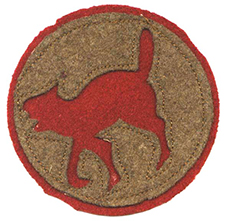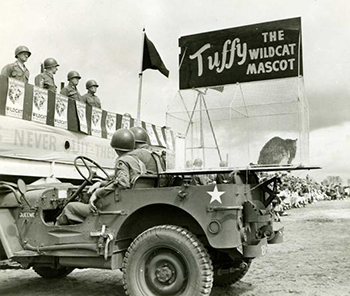
The Wildcat Division, a World War I unit officially known as the Eighty-first National Army Division, was organized in August 1917 with drafted soldiers, mostly from North Carolina, South Carolina, and Florida. Approximately one-third of the soldiers were North Carolinians from almost every part of the state. Two regiments-the 321st Infantry and the 316th Field Artillery-and the 321st Ambulance Company were made up almost exclusively of North Carolinians. The division was called the "Wildcat" Division in recognition of the irascible wildcats that inhabited southern states and after Wildcat Creek, which ran near Camp Jackson, S.C., where the unit was mobilized. The men adopted a wildcat silhouette as a shoulder patch, the first insignia worn by troops in the American Expeditionary Force.
In 1918 the Wildcat Division sailed for Europe where, after additional combat instruction, it was sent on 19 September to the St. Dié sector of France's Vosges Mountain region. There, as part of the French Seventh Army, the division held what was considered a quiet front, although it fought off German trench raids and endured artillery bombardments. On 19 October the Eighty-first was relieved and ordered to the rear to await transfer to the American 1st Army, which was fighting in the Meuse-Argonne offensive. While serving in the St. Dié sector, the division suffered 116 casualties.

In early November 1918 the Eighty-first moved to the front lines near Verdun, where its infantry regiments attacked German lines on the morning of 9 November. From the outset the division encountered heavy machine gun and artillery fire; heavy fog and smoke hindered visibility but also likely saved American lives in the attack. By late afternoon, the 322nd Infantry Regiment had captured the ruined village of Moranville. On the south side of the forest, the 324th Infantry Regiment slowly pushed the enemy back but then abandoned much of the ground by withdrawing to a safer position. The day's fighting produced mixed results, with success north of Bois de Manheulles and frustration south of the forest.
When on the night of 10 November Wildcat Division commanders received no official confirmation of rumors that an armistice might be signed the next day, the 321st and 323rd Infantry Regiments planned a dawn attack on the main German trench line. At daybreak the 321st went "over the top" for the first time and attacked enemy trench positions north of Bois de Manheulles, slowly advancing through heavy fog and shell and machine gun fire. At 10:30 a.m. the 323rd began to fight its way through the barbed wire entanglements along the German main trench line into and south of Bois de Manheulles; some Americans entered German trenches and many were either killed or pinned down under enemy fire. At 11:00 a.m. the firing abruptly stopped when the armistice of 11 Nov. 1918 ended hostilities.
Following the armistice, the Wildcat Division marched 175 miles to a rest area and in early June returned to the United States. During the short time the Eighty-first was in combat, it suffered 248 killed and 856 wounded.